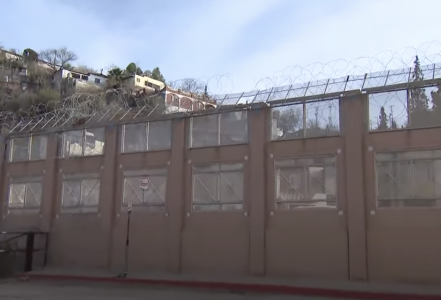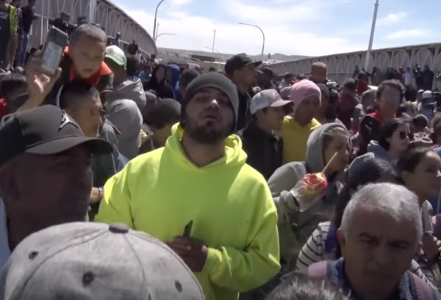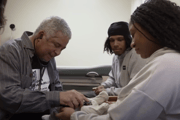Tighter US border controls spur shift to riskier crossings
- Replies 0
The US-Mexico border has always been a place of hope, hardship, and headlines. But in recent years, as border security has tightened and policies have shifted, the story has taken a darker, more dangerous turn.
Here at The GrayVine, we believe in looking beyond the headlines to understand the real human stories—and the new, often deadly, tactics that are emerging as desperate migrants and cunning smugglers try to outmaneuver the ever-evolving border clampdown.
A Drop in Apprehensions, But Not in Desperation
Despite a 90% drop in apprehensions since President Trump took office, migrants continue to attempt border crossings—now via increasingly perilous routes, according to US authorities and aid groups.
Smugglers have adapted by sending migrants through remote deserts and mountains alone, guiding them via cellphones and WhatsApp.
“They’re directing people through cellphones, giving them coordinates,” said Jesus Vasavilbaso, a Border Patrol agent in Tucson, Arizona. “Now that many people carry cellphones, they’re being left to their own devices.”
Migrants are often found dehydrated and camouflaged, wearing carpet on their shoes to avoid leaving tracks.

These are part of smuggling “kits” sold by coyotes that include water, food, camouflage, and phones. “If you don’t buy that kit, they won’t let you cross,” Vasavilbaso explained.
Smugglers are guiding people through treacherous locations like Otay Mountain, where in February, three migrants died during a freezing storm.
In March, two women (one pregnant) were rescued after being stranded with injuries and no supplies. “As we start seeing more closures of traditional crossing points, the crossings become much more dangerous,” warned Pedro Ríos, a migrant advocate in San Diego.
In Arizona, crossings are shifting to remote zones like the Sonoran Desert and Cabeza Prieta Wildlife Refuge, where temperatures reach 118°F.
Migrants often walk 45 miles over several days with limited water. In 2024, 154 remains were found in Arizona’s deserts; 40 more have been found so far in 2025, many presumed to be from earlier years.

“The flow is shifting to western Arizona,” said Brad Jones of Humane Borders. “It’s even more remote, and humanitarian groups are forbidden from entering military zones.”
These include the Barry M. Goldwater Air Force Range, where NGO Armadillos once found 12 migrant bodies, possibly bomb victims. Migrants now face 6–10 day treks to highways, often with just eight gallons of water, said group founder César Ortigoza.
“Smuggling through remote desert areas poses significant danger, particularly for families,” said Border Patrol Chief Sean McGoffin.
Even in Texas, smuggling remains deadly. On March 28, two Guatemalan migrants, including a 14-year-old boy, drowned after a smuggler drove into a canal while fleeing police. His mother, who survived, had paid $16,000 for transport to Los Angeles.
Source: 12 News / Youtube.
Migrants pay between $2,500 to $7,000 to cross, with bracelets indicating cartel payment.
On May 9, agents in Laredo caught four migrants and their smuggler, who had charged $7,000 for the trip.
On May 22, three more migrants, including one who paid $2,500, were arrested in McAllen, Texas. A 15-year-old smuggler from Reynosa told police he was paid $150 per person and used encrypted GPS instructions.
Still, he warned: “Don’t take the risk. It’s dangerous, and the likelihood of being detected, detained, and deported is higher than ever.”

Have you or someone you know been touched by the realities of border migration? What do you think is the answer to this ongoing crisis? Share your thoughts, stories, and questions in the comments below!
Here at The GrayVine, we believe in looking beyond the headlines to understand the real human stories—and the new, often deadly, tactics that are emerging as desperate migrants and cunning smugglers try to outmaneuver the ever-evolving border clampdown.
A Drop in Apprehensions, But Not in Desperation
Despite a 90% drop in apprehensions since President Trump took office, migrants continue to attempt border crossings—now via increasingly perilous routes, according to US authorities and aid groups.
Smugglers have adapted by sending migrants through remote deserts and mountains alone, guiding them via cellphones and WhatsApp.
“They’re directing people through cellphones, giving them coordinates,” said Jesus Vasavilbaso, a Border Patrol agent in Tucson, Arizona. “Now that many people carry cellphones, they’re being left to their own devices.”
Migrants are often found dehydrated and camouflaged, wearing carpet on their shoes to avoid leaving tracks.

Despite a sharp drop in border apprehensions since Trump’s border crackdown, migrants are still making attempts to cross into the US—increasingly by taking riskier, deadlier routes through deserts and mountains. Image source: 12 News / Youtube.
These are part of smuggling “kits” sold by coyotes that include water, food, camouflage, and phones. “If you don’t buy that kit, they won’t let you cross,” Vasavilbaso explained.
Fatal Consequences of New Routes
Between February and April, 24,000 apprehensions were reported, especially in Texas, Arizona, and California. Mexicans now represent 73% of migrants detained, a shift from recent years.Smugglers are guiding people through treacherous locations like Otay Mountain, where in February, three migrants died during a freezing storm.
In March, two women (one pregnant) were rescued after being stranded with injuries and no supplies. “As we start seeing more closures of traditional crossing points, the crossings become much more dangerous,” warned Pedro Ríos, a migrant advocate in San Diego.
In Arizona, crossings are shifting to remote zones like the Sonoran Desert and Cabeza Prieta Wildlife Refuge, where temperatures reach 118°F.
Migrants often walk 45 miles over several days with limited water. In 2024, 154 remains were found in Arizona’s deserts; 40 more have been found so far in 2025, many presumed to be from earlier years.

Smugglers (or “coyotes”) now often rely on technology, guiding migrants remotely with mobile phones rather than accompanying them in person, which leaves many migrants lost and vulnerable in harsh terrain. Image source: 12 News / Youtube.
“The flow is shifting to western Arizona,” said Brad Jones of Humane Borders. “It’s even more remote, and humanitarian groups are forbidden from entering military zones.”
These include the Barry M. Goldwater Air Force Range, where NGO Armadillos once found 12 migrant bodies, possibly bomb victims. Migrants now face 6–10 day treks to highways, often with just eight gallons of water, said group founder César Ortigoza.
Deadly Risks Persist Despite Crackdowns
On May 21, agents near Lukeville, Arizona, intercepted a smuggler walking with four migrants, including a woman from Uzbekistan and two children.“Smuggling through remote desert areas poses significant danger, particularly for families,” said Border Patrol Chief Sean McGoffin.
Even in Texas, smuggling remains deadly. On March 28, two Guatemalan migrants, including a 14-year-old boy, drowned after a smuggler drove into a canal while fleeing police. His mother, who survived, had paid $16,000 for transport to Los Angeles.
Criminal Control and Profits
Despite enforcement, human smuggling remains highly profitable. “Criminal organizations control the border on the Mexican side, and no one crosses without their permission,” Vasavilbaso noted.Source: 12 News / Youtube.
Migrants pay between $2,500 to $7,000 to cross, with bracelets indicating cartel payment.
On May 9, agents in Laredo caught four migrants and their smuggler, who had charged $7,000 for the trip.
On May 22, three more migrants, including one who paid $2,500, were arrested in McAllen, Texas. A 15-year-old smuggler from Reynosa told police he was paid $150 per person and used encrypted GPS instructions.
No End in Sight
“Humans will always look for a way to find a better life,” Vasavilbaso said. “I think it’s impossible to stop it, but we can have a controlled way of how people migrate.”Still, he warned: “Don’t take the risk. It’s dangerous, and the likelihood of being detected, detained, and deported is higher than ever.”
Key Takeaways
- Despite a sharp drop in border apprehensions since Trump’s border crackdown, migrants are still making attempts to cross into the US—increasingly by taking riskier, deadlier routes through deserts and mountains.
- Smugglers (or “coyotes”) now often rely on technology, guiding migrants remotely with mobile phones rather than accompanying them in person, which leaves many migrants lost and vulnerable in harsh terrain.
- Traditional crossing points are heavily fortified, pushing migrants into remote areas like the Sonoran Desert and Otay Mountain, where extreme conditions have led to a rise in deaths and the discovery of numerous migrant remains.
- Human smuggling remains big business for criminal groups on the Mexican side, with migrants paying thousands for “crossing packages”—but the journey is more dangerous than ever, and authorities warn being caught, detained, or even killed is a significant risk.
Have you or someone you know been touched by the realities of border migration? What do you think is the answer to this ongoing crisis? Share your thoughts, stories, and questions in the comments below!






